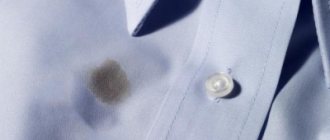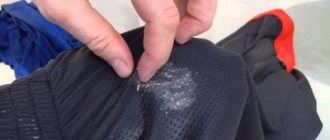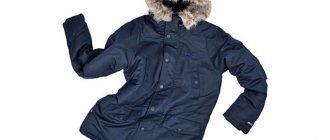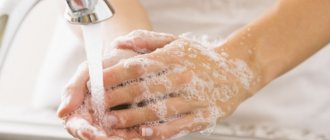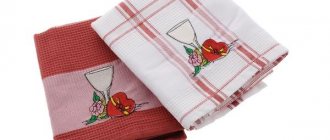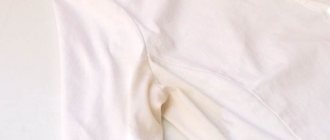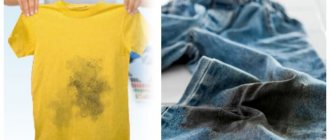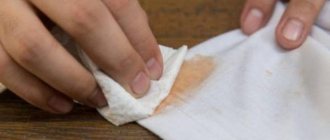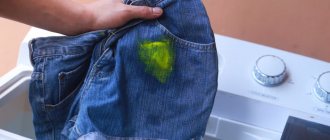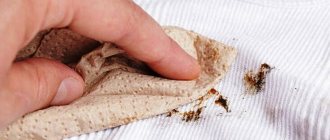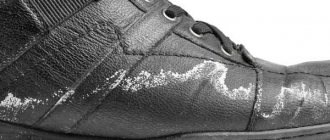High-quality powders and functional washing machines can cope with almost any contaminant, but even they are powerless. How to remove an old grease stain from clothes with your own hands, using household products? The information will be useful to many housewives and will extend the life of your favorite clothes. You can get rid of stains with the usual substances that you have on hand.
General rules and preparation for removing grease stains
Stains from berries, fruits, and food will not just come off your clothes, no matter how expensive the powder is. If there are doubts that the washing machine will not cope with removing greasy stains, then you should not try to increase the dose of the cleaning agent and the procedure time. Old greasy stains on clothes do not react to the active ingredients of the washing powder.
The effectiveness of stain removal directly depends on the start time of the operation. Most vegetable fats belong to the drying class. Over time, they form a dense structure that reacts poorly to household chemicals.
Ideally, you need to neutralize its effect in the first minutes of contact with clothing and reduce its amount to a minimum. This will make washing much easier later.
Folk remedies
Gasoline, acetone, turpentine can remove the stain along with the paint.
Proven folk remedies will help you wash off a grease stain from denim. Before use, some of them should be pre-tested so as not to damage the fabric. These substances include gasoline, which has good cleaning properties, but requires careful use. It is applied to the stain very carefully, literally a few drops, left for a few minutes, then rinsed off thoroughly and the item is machine washed. For difficult stains, you can prepare a mixture of gasoline and acetone in equal parts. After this treatment, the trousers are washed twice.
To help clean the stain:
- Grated potatoes. Cover the stain thickly with the mixture, leaving it for half an hour. After removing the potatoes, the cloth is cleaned with a stale crust of black bread.
- Adsorbents - soda, chalk, starch, mustard or tooth powder. The stain is sprinkled with powder, which absorbs the grease. Adsorbent agents are only suitable for removing fresh stains.
- Table vinegar is good for both fresh and old stains. Apply it to a cotton swab and blot away the dirt. However, this product, like gasoline, requires preliminary testing.
- Toothpaste. Apply an even dense layer to the entire surface of the stain and leave for half an hour, then wash by hand or in a machine.
- Ammonia. Use a swab moistened with this product to remove stains from light-colored trousers.
Precautions must be taken during cleaning. When machine washing, the temperature is set in the range of 30-40 degrees. Pants must be turned inside out before washing. Boiling and the use of bleach are excluded.
What and how can you remove an old grease stain?
Experience has shown which means and methods will really help and which will not. The capabilities of the modern chemical industry make it possible to obtain new substances with unique qualities, but in some cases old, proven methods turn out to be effective, and most importantly, less expensive and more gentle on tissues. The information will help you decide how to remove fat stains.
Stain removers
The range of products is huge. There are universal and targeted cleaning agents. It is better to purchase a product that specifically removes fat. You should carefully read the composition. The active ingredient may be:
- Sorbents. They work well only in the first minutes. Particles of the substance absorb fresh fat, old dirt is difficult to remove.
- Solvents. Actively affects fabric dyes. Many products in this category can be replaced with gasoline, acetone and other organic solvents, which are often used to remove stains in the household.
- Chlorine. Good for whitening. Fat, especially old fat, is not removed very well. Not safe for colored items.
- Enzymes. They are excellent at removing fruit and berry juices and traces of grass, but are not as effective in dealing with greasy stains.
- Oxygen. It works softer and more gentle than chlorine with approximately the same effect. Recommended for use on fresh greasy stains.
We recommend reading: Rules for the care and methods of cleaning suede shoes
Many factory cleaners can be replaced with substances found in any home. While expensive products from well-known manufacturers who care about their reputation are truly a good choice, dubiously produced products are no better than self-prepared formulations.
Laundry soap
Actively acts on fabric fibers, softening organic substances and without affecting dyes. It is important to actively influence physically with this method. The moistened item in the area of the greasy stain is rubbed with soap. Leave for several hours, then vigorously wash the area and rinse. If the removal is not complete, the procedure is repeated.
Steam treatment
The method is effective in the first minutes and hours after contamination. Under the influence of high temperature, fat becomes more mobile. It is necessary to place an absorbent base under the stain, for example, a napkin, tracing paper, or paper. If the iron is not equipped with a steaming function, then you can proceed as follows - hold the greasy stain over the spout of a boiling kettle for several minutes, then quickly spread it onto an absorbent base and iron it with a regular iron. The operation can be done several times until visible signs of contamination disappear.
Hot starch
The substance perfectly absorbs fat. If the starch is preheated, the process is accelerated many times over. To increase efficiency, you need to press the fabric tightly against the starch. One option for using this method is to iron it with a dry, hot iron over fabric laid out on a layer of starch. It is recommended to do the procedure several times, removing the old one and adding a new portion of the substance.
Glycerol
A small molecule of a substance can penetrate many substances, including fat. Glycerin has a destructive effect on oil stains. A few drops of the substance are applied to the desired area until completely absorbed. After a few hours, wash thoroughly. You can prepare a composition from equal parts of ammonia, glycerin and water. The mixture is applied to the surface to be cleaned and actively rubbed for effectiveness. The substance is gentle on the structure of the fabric and this method is often used for processing delicate fabrics.
Alcohol
Excellent grease solvent. Unlike products based on petroleum refining, it evaporates completely, leaving no odor or streaks. It is gentle on dyes and is considered one of the best means for breaking down fresh greasy stains. It removes old stains less well, but can significantly soften fat for treatment with other preparations. Often used before applying alkaline cleaning products, increasing their effectiveness.
We recommend reading: The best ways to remove iron marks on dark and light fabrics
Gasoline and acetone
The appearance of dry cleaning was due to kerosene accidentally spilled on an old tablecloth, its composition close to gasoline and other petroleum distillation products. This group of substances has long been used in the professional processing of things. When working with gasoline and acetone, you need to be careful. Firstly, the substance is flammable, and, secondly, it has a powerful degreasing effect on the skin of the hands, drying it out. When handling old grease stains, you need to wear rubber gloves.
Hot brine
A method that allows you to effectively remove grease stains at minimal cost. It is very good to use a boiling saline solution. Add salt to the kettle at the rate of 150 g per liter of water. The fresh stain is watered from the spout. It is better to soak old stains in a hot solution until it cools completely. The procedure, if necessary, is repeated several times. Salt is an active bleacher, so natural fabrics may lose their bright colors and fade.
Turpentine and ammonia
Ammonia is considered one of the best grease removers and is often included in industrial products. You can prepare the following mixture yourself: turpentine is mixed in a 1:1 ratio with pharmaceutical ammonia. Wipe the greasy stain with the mixture. Leave for an hour and a half. After this, we wash off the old greasy stains by hand or in a machine. The gentle effect on fibers allows the method to be used when cleaning fabrics subject to shedding and shrinkage.
Vinegar
Housewives often use this remedy. Every kitchen has vinegar. How to remove old greasy stains from clothes with this substance? If you treat the area with vinegar in the first minutes after the grease gets in, this will allow you to avoid a labor-intensive procedure in the future. For degreasing, only table or diluted vinegar is used. After application, leave it for 15–20 minutes, after which the item is rinsed. If contamination remains, the procedure is repeated.
Soda and dishwashing liquid
The method has long been successfully used to remove old stains. They use both dry powder, sprinkling it on the dirt, and a solution, blotting the desired area of the item with it. Dishwashing liquids contain soda or substances with similar effects. A damp cloth with dirt is soaked in the product and left for a while; when mixed with water, it works even better than concentrate, fighting stubborn greasy stains.
How to remove fresh dirt?
When a stain has just appeared, it is important to try to eliminate it as quickly as possible. The more time passes from the moment the grease gets on the fabric, the more difficult it will be to clean.
In a few hours, the fat has time to be deeply absorbed into the fibers, so it is necessary to act quickly. The main task is to localize the site of contamination and prevent fat from penetrating deeply into the structure of the material.
In this case , improvised means that are good sorbents will help:
- rock salt,
- starch,
- talc,
- chalk.
Any of the products is poured onto the stain and distributed by rubbing in a circular motion. As the fat is absorbed, the powder is shaken off the T-shirt and a new one is added.
You can also use dishwashing gel . It is applied from the package directly to the stain and carefully distributed. Leave it in this form for 15-30 minutes, after which the T-shirt is washed.
It is not advisable to use colored dish gels, especially on a white T-shirt, as they can leave behind colored stains.
How to remove a grease stain from jeans?
A special feature of the fabric is the dye - denim. Denim fades with any wash. How to remove greasy stains without ruining the item? The dye is not resistant to wet abrasion. This makes it difficult to remove grease stains from jeans. Active substances can only be used on old, washed items; new ones are treated exclusively with delicate products. At home, you can use a composition based on ammonia, glycerin, and hot starch.
Industrial household chemicals
Manufacturers of household chemicals have developed many different universal stain removers that are designed to remove a wide range of stains. You can choose the right product for white and colored items, for natural or synthetic fabrics.
If oil gets on your clothes, immediately moisten the stained area with any of the popular stain removers:
- Vanish Oxi Action;
- Antipyatin;
- Amway;
- Ecover Ecological Stain Remover;
- ACE Oxi Magic.
But most of them only remove fresh grease stains well, and cannot cope with old ones. To solve this problem, you need to use stain removers specially designed for removing greasy stains or products based on bile soap:
- Dr.Beckmann Expert fats and sauces – perfectly removes stains based on vegetable and animal fat;
- Lion Top for removing stains from collars and cuffs;
- Frau Schmidt “Double action formula”;
- Dr.Frash for removing stubborn stains of various origins;
- stain removal gel based on Dr. Beckmann gall soap;
- Heitmann Liquid bile soap.
These stain removers remove the most stubborn stains from white and colored items very delicately, without causing harm to the product. Unfortunately, products are rarely sold in household chemicals departments in supermarkets, but they are easy to purchase by placing an order in an online store.
Gentle removal of greasy stains from delicate fabrics
Things made from thin materials require a special approach. How to wash fabric without damaging it? When choosing a stain removal product, delicate fabrics must be tested. A small amount of the substance is applied to an area of fabric that is not visible when worn. For example, hem turns, sleeves, areas under patch pockets, collars and appliqués. Compositions based on ammonia and glycerin have proven themselves to be gentle, so try them first. If there is a reaction to them, then you should not try more active mixtures and it is better to dry clean the item.
In conclusion, we can say that in most cases, grease stains can be easily removed at home. It's important to do this quickly. If you treat this area with improvised means in the first minutes, then most likely there will be no traces left. It is much more difficult to remove fat after several hours. An item that has been left with a greasy stain for several days or even weeks will require the use of active substances and physical labor. If the item has been washed and has been lying around for some time, then even professional dry cleaning cannot always effectively cope with the task.
General recommendations
To remove old stains efficiently, follow the preparatory steps and recommendations:
- Determine the type of fabric and approved cleaning methods in order to prevent streaks and holes. Carefully study the symbols on the product tag, which will indicate the washing, cleaning, and ironing modes.
- Select a grease remover based on the type and color of the fabric.
- Clean the item from dirt with a clothes brush.
- After choosing a cleaning product, test the color fastness of the fabric on an area of the garment that is hidden from prying eyes (inner pockets, inside cuffs, hem of shirt, seam allowances). If the fabric sheds during contact with the cleaning agent, choose a different method.
- Treat the stain from the inside out, laying the clothes on a flat, clean surface: a board, a table, an ironing board. Before starting the procedure, place several layers of light, plain knitwear under it.
- To prevent stains from creeping in, moisten the area around the stain with plain water or sprinkle with talcum powder or starch.
- To soften old grease stains, moisten them with glycerin.
Do not use acetone or acetic acid on acetate silk to prevent holes from forming on it. Use alkalis and chlorine only on white fabrics.
Preparation
For most women, a drop of fat that gets on their outfit causes genuine horror. And all because experienced housewives know that removing contamination is not so easy, and you will have to work hard.
This happens because the fat penetrates the fiber structure and, when solidified, is securely bonded to the base.
Hence the conclusion that fresh stains come off best. Therefore, the problem must be eliminated as soon as possible. Success is almost guaranteed if you take action in the first three hours.
Don’t think that adding more washing time and adding more powder will help remove the stain. On the contrary, fat will only become more firmly entrenched in the tissue and will be difficult to remove. Therefore, you cannot wash dirty clothes without pre-treatment.
Also keep in mind that different types of materials use different methods for removing dirt.
A few words about the withdrawal procedure.
Firstly , any product must first be applied to a clean surface around the stain, and then treat the shiny mark, moving from the edges of the mark to the center. This will prevent the “spreading” of contamination.
Secondly , before cleaning, it is advisable to shake off dust from the product and remove dry dirt with a brush.
Thirdly , before application, any product should be tested from the reverse side in a hidden area. And only if the material has not reacted in any way can the composition be used.
Fourthly , after the manipulations, the outfit must be rinsed by hand, and then it can be washed in a machine. This rule is especially true for solvents and strong-smelling substances.
Specifics of contaminants from butter, vegetable, and motor oils
Serious problems often arise when removing traces of various fats. This should not be surprising; the whole point is that when washing, water is used, and it is a polar compound, while oil is not.
Simply put, there is no direct contact, the contaminant cannot dissolve and, therefore, is not washed out of the fibers. This is prevented by a physical phenomenon such as the surface tension of water. In the case under consideration, it is quite possible to reduce it.
This is done in several ways. In particular, heat is used. In addition to it, solutions based on surfactants (surfactants) are effective.
The latter separate water molecules and thereby help them penetrate the fibers. They also stick to fats and ensure their interaction with liquid. As a result, an emulsion is formed that is easily removed from the material.
It is also important to take into account the nature of the pollution. Thus, vegetable oils (sunflower, sea buckthorn, olive) mainly consist of fatty acids and essential derivatives of glycerol. For this reason, they respond well to an alkaline environment that promotes saponification.
Edible oils also decompose when heated above 250 °C. As a result, a specific compound is formed - acrolein and a number of fatty acids. These decomposition products are easily removed during normal washing.
The properties of butter are in many ways similar to those of vegetable oil. For this reason, stains formed by it are removed using the same methods.
In the case of petroleum products, everything is not so simple. Machine oil contains mainly saturated carbohydrates, which are completely unaffected by alkaline compounds and high temperature. Only a solvent will save the situation here.
As such it is permissible to use:
- turpentine;
- denatured alcohol;
- ether.
What not to do
When figuring out exactly what to use to remove an oil stain from your favorite clothes, it is important to clearly understand which actions will not bring any effect.
A number of sites recommend using bleach. However, the caveat is that they primarily ensure the removal of colored contaminants, and fats are usually colorless. Moreover, it does not matter which preparation is used - both chlorine-containing ones and those without this component ultimately form free oxygen. It leads to the fixation of fat on the fibers. The reaction is completed after drying. If you follow this advice, you can guarantee that the stain will remain forever.
Hot water is quite effective, but only when it comes to very small drops of oil. High temperature increases the fluidity of the product, and it spreads over a large area, which is enough to restore the appearance of the item. Large stains cannot be removed using this method.
Sometimes there are recommendations to clean pants or other clothing with various plumbing care products. In principle, the caustic soda contained in them actually breaks down oils. The trouble is that it also has a destructive effect on many types of textiles.
Important: to avoid unpleasant surprises, be sure to try the selected composition on an inconspicuous area of clothing and make sure that the fabric will survive contact with the aggressive substance.
Several more cleaning options
The listed remedies are effective, but they do not exhaust all possible options. Below are some more effective options for this procedure:
- Shaving foam can be used for this purpose. To clean, you need to soak the greasy stain in it. If you lightly rub the knitwear and leave it for five minutes, the stain will disappear. After this, it is recommended to wash the item.
- In this situation, glycerin can help. Apply several times to the greasy stain and leave the knitwear for half an hour. Then you need to rub it and then wash it.
- Some soft drinks have a cleansing effect. If you use Coca-Cola or Sprite, you can remove fat without a trace. To do this, you will need to pour this product into a basin and place the item of clothing in this liquid for three hours. After finishing cleaning, you will need to do a wash.
The methods given here will help you remove grease from clothes..
Some tips
- Before washing, carefully inspect your clothing for stains. This way you can find fresh contaminants that have not had time to be absorbed and dry. Thus, you do not have to use special tools.
- Use a brush to clean. By removing the dried dirt, you will see how much the fibers have absorbed the grease.
- Choose your product carefully. It must treat the material with care. Check first how the composition works. Apply it on an inconspicuous part of the item. So, for example, when using a product suitable for a cotton product on a woolen item, its fibers may be damaged. Which will significantly spoil the appearance of the product.
- Use methods of increasing effectiveness. Use less aggressive methods first, and if they don't work, move on to more effective methods.
- When using a brush, you need to move from the edges to the center. With these movements you will prevent the appearance of streaks, and the oily area will not spread any more.
After using any method, be sure to wash or rinse the item to get rid of odors and product residues.
How else can you remove a stain: universal store-bought stain removers
Any hardware store now sells a lot of products that are guaranteed to get rid of contaminants of a wide variety of nature. They are easy to use - you just need to follow the included instructions exactly.
Antipyatin soap is a very effective option. This product will cost (for a bar weighing 90 g) only 45-50 rubles. The problem is that it doesn't do a very good job of removing stubborn oil marks.
Use soap this way:
- moisten the stained area of clothing;
- rub with Antipyatin;
- leave for 2 or 3 hours;
- when the time is up, rinse;
- Wash by hand or in a machine.
Vanish Gold Oxy Action is considered a very reliable product. The manufacturer directly recommends it to anyone who needs to get rid of greasy stains on clothes. For a kilogram jar you will have to pay a little less than 500 rubles.
To remove oil traces from an item, you need to pour 60 ml of gel into 4 liters of water (not warmer than 40 °C). The clothes are soaked in the resulting solution. If we are talking about colored fabrics, then an hour is enough, but when you have to clean white ones, wait 6 times longer.
Then wash your clothes in the machine, adding another 60 ml of Vanish directly into the drum. The described preparation is not suitable for natural silk, leather and wool products, but is suitable, for example, for denim items.
Quite a budget product - soap with a stain remover effect from the Frau Schmidt brand. It can get rid of the stains in question from any dense and knitted, cotton, and synthetic fabrics. It costs only 100 rubles.
How to use soap:
- moisten the greasy blot with water;
- rub it with a bar from the edges to the middle;
- wait a quarter of an hour;
- put it in the machine for rinsing.
The mentioned stain remover can also be used on colored clothes. Before use, we recommend that you test it on an inconspicuous fragment of the affected item of clothing.
“SA8 Prewash Spray” (SA8 Prewash Spray) from Amway is quite expensive. For a bottle with a volume of less than 300 ml you need to pay 700 rubles. However, it is economical and easy to use.
It is enough to spray the liquid onto the problem area from a distance of at least 15 cm. Then leave the product for about 10 minutes, and then immediately begin washing.
The manufacturer emphasizes that the effect will be higher the less time passes from the moment the contamination is applied to the start of its removal.
Ecover stain remover is a completely environmentally friendly product and will cost relatively little - 300 rubles. You just need to moisten the stained area of clothing with the product.
It is also recommended to rub the problem area with a brush built into the bottle cap. Next, the item is washed by machine or hand. The manufacturer does not recommend using Ecover on silk, wool and other delicate materials.
When choosing a suitable product, you need to pay attention to the recommendations and restrictions - all this is described in the instructions printed on the packaging.
Important: even substances positioned as safe can cause allergies in people prone to such reactions. Therefore, be sure to wear gloves when working with them.
